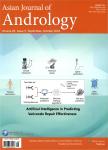Oncological results, functional outcomes and health-related quality-of-life in men who received a radical prostatectomy or external beam radiation therapy for localized prostate cancer: a study on long-term patient outcome with risk stratification
Oncological results, functional outcomes and health-related quality-of-life in men who received a radical prostatectomy or external beam radiation therapy for localized prostate cancer: a study on long-term patient outcome with risk stratification作者机构:Division of Urology Department of Regenerative and Sciences Niigata University Niigata 951-8510 Japan Transplant Medicine Graduate School of Medical and Dental Division of Radiation Oncology Department of Molecular Genetics Graduate School of Medical and Dental Sciences Niigata University Niigata 951-8510 Japan
出 版 物:《Asian Journal of Andrology》 (亚洲男性学杂志(英文版))
年 卷 期:2009年第11卷第3期
页 面:283-290页
核心收录:
学科分类:1002[医学-临床医学] 1010[医学-医学技术(可授医学、理学学位)] 100214[医学-肿瘤学] 100215[医学-康复医学与理疗学] 10[医学]
主 题:long-term observation quality-of-life radiation therapy radical prostatectomy risk stratification
摘 要:Health-related quality-of-life (HRQOL) after a radical prostatectomy (RP) or extemal beam radiation therapy (EBRT) has not been studied in conjunction with oncological outcomes in relation to disease risk stratification. Moreover, the long-term outcomes of these treatment approaches have not been studied. We retrospectively analyzed oncological outcomes between consecutive patients receiving RP (n = 86) and EBRT (n = 76) for localized prostate cancer. HRQOL and functional outcomes could be assessed in 62 RP (79%) and 54 EBRT (79%) patients over a 3-year follow-up period (median: 41 months) using the Medical Outcomes Study Short Form-36 (SF-36) and the University of Califomia Los Angeles Prostate Cancer Index (UCLA PCI). The 5-year biochemical progression-free survival did not differ between the RP and EBRT groups for low-risk (74.6% vs. 75.0%, P = 0.931) and intermediate-risk (61.3% vs. 71.1%, P = 0.691) patients. For high-risk patients, progression-free survival was lower in the RP group (45.1%) than in the EBRT group (79.7%) (P = 0.002). The general HRQOL was comparable between the two groups. Regarding functional outcomes, the RP group reported lower scores on urinary function and less urinary bother and sexual bother than the EBRT group (P 〈 0.001, P 〈 0.05 and P 〈 0.001, respectively). With risk stratification, the low- and intermediate-risk patients in the RP group reported poorer urinary function than patients in the EBRT group (P 〈 0.001 for each). The sexual function of the high-risk patients in the EBRT group was better than that of the same risk RP patients (P 〈 0.001). Biochemical recurrence was not associated with the UCLA PCI score in either group. In conclusion, low- to intermediate-risk patients treated with an RP may report relatively decreased urinary function during long-term follow-up. The patient's HRQOL after treatment did not depend on biochemical recurrence.




